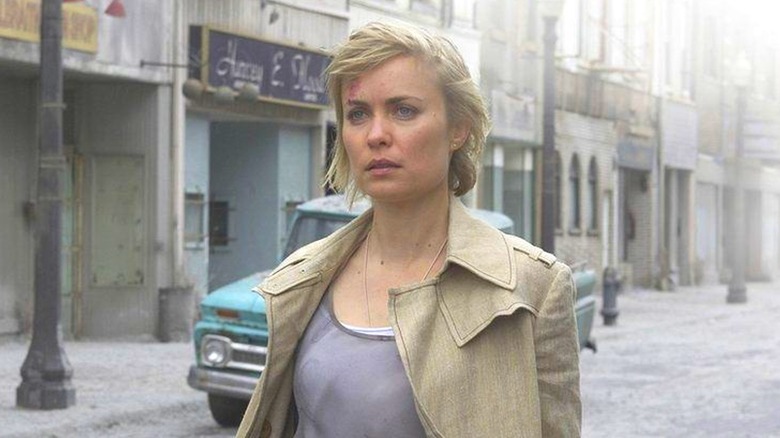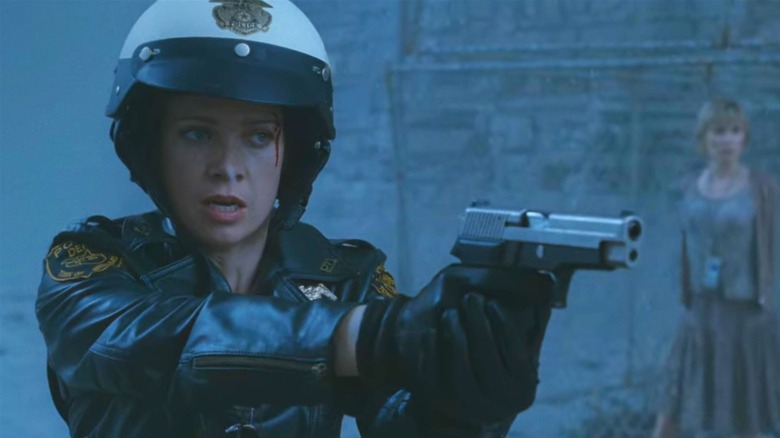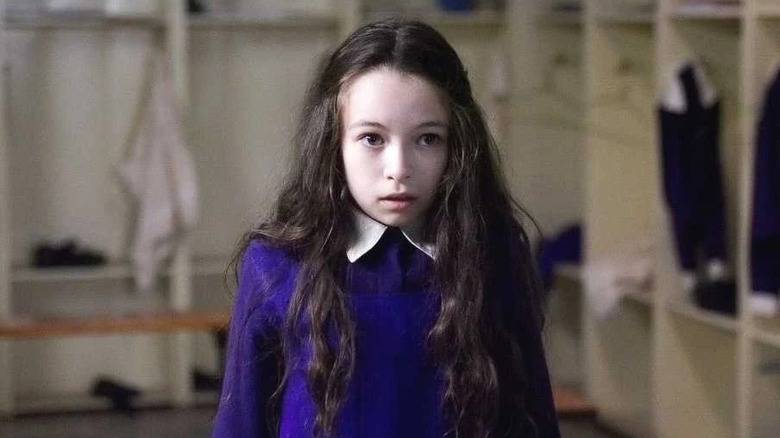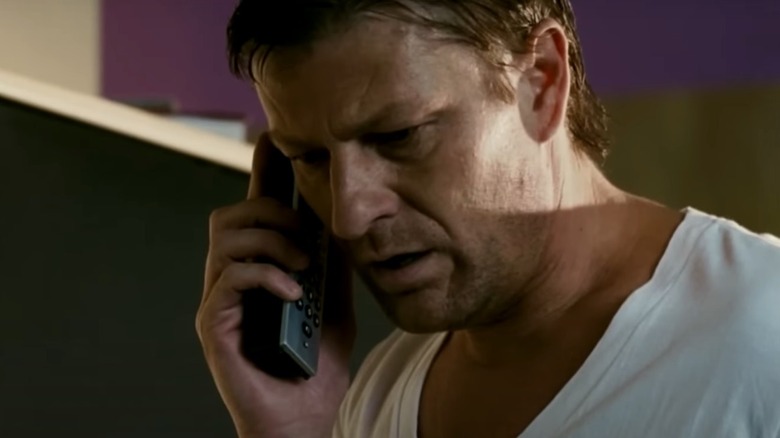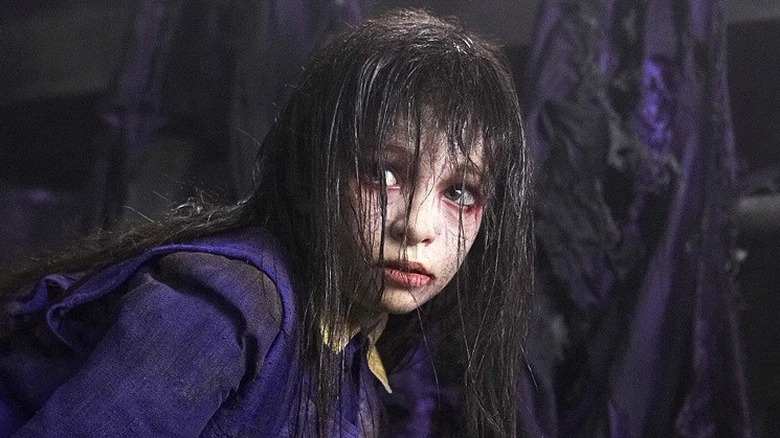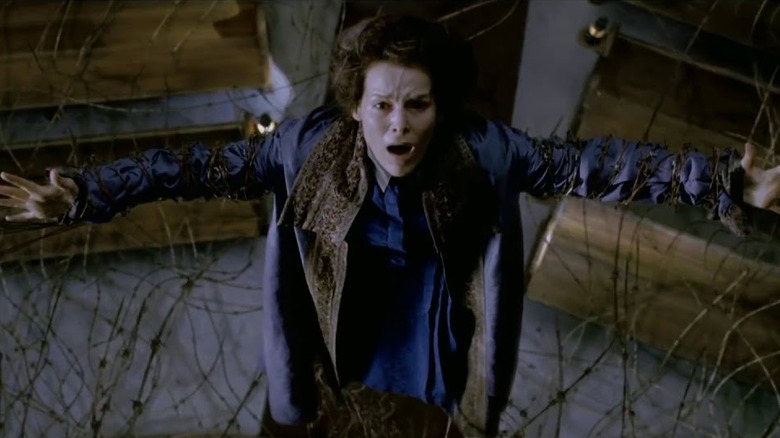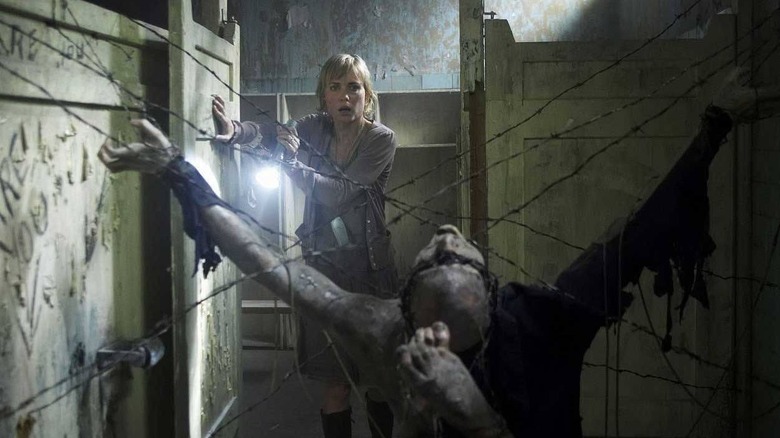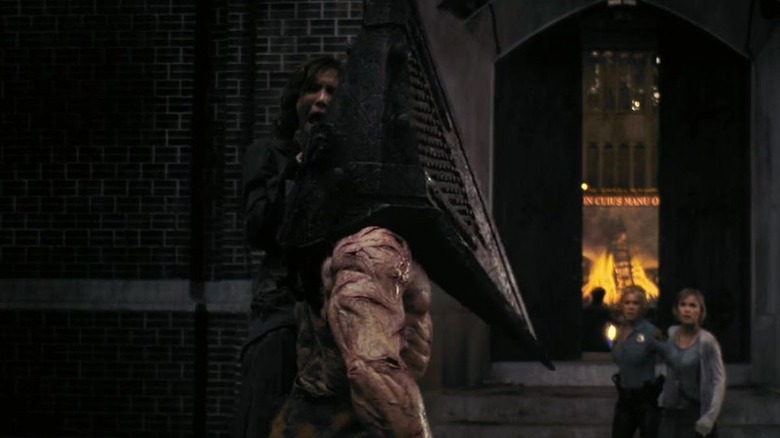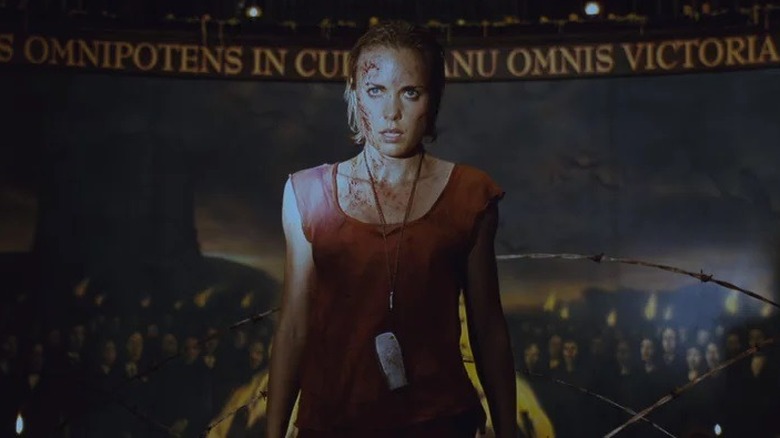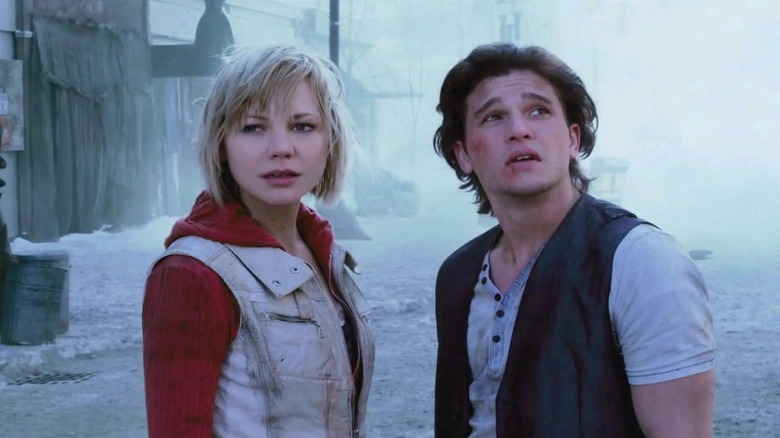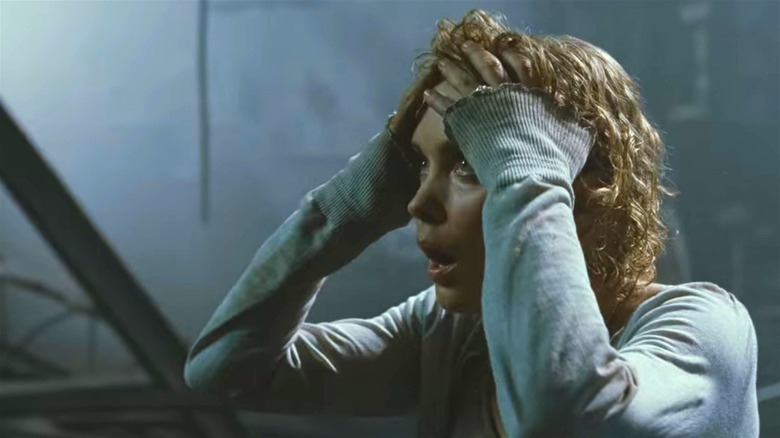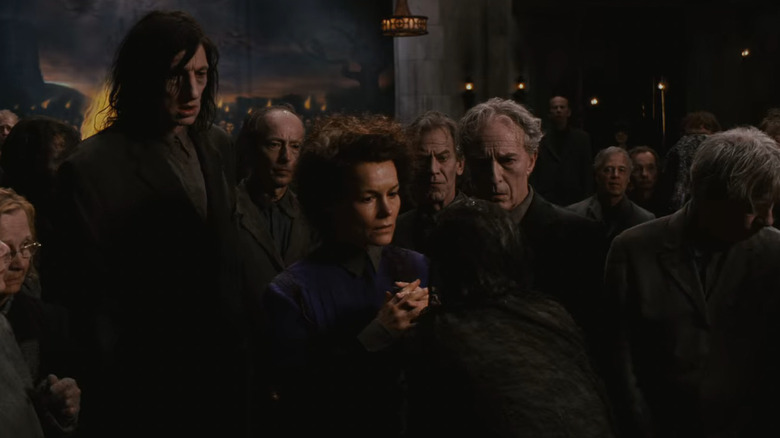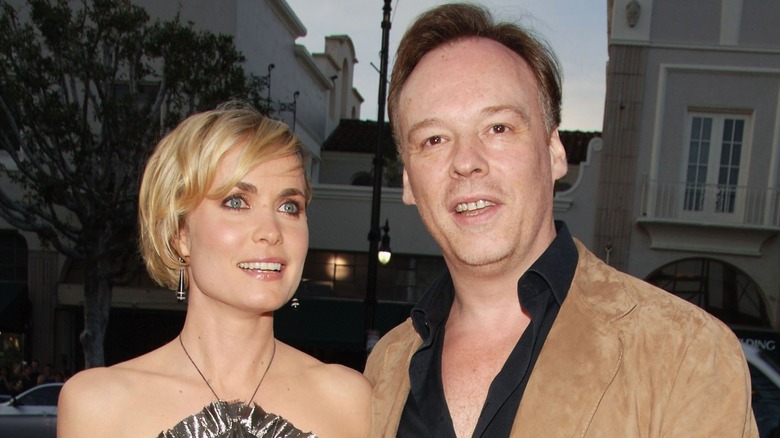The Ending Of Silent Hill Explained
Based on the acclaimed horror video game series, 2006's "Silent Hill" stars Radha Mitchell and Sean Bean as Rose and Christopher Da Silva, a loving couple who adopted a little girl named Sharon (Jodelle Ferland). When Sharon begins having nightmares about a strange town called Silent Hill, Rose believes the only way to make them stop is to take her daughter to the town herself. Upon arrival, they discover that Silent Hill is no ordinary town, but a nightmarish world hiding a dark secret from its sordid past.
Full of jaw-dropping imagery, "Silent Hill" may be the first video game adaptation to truly capture the feel of its source material. While there are many stark differences between the film and the original game, one thing they share is a storyline that's anything but straightforward. It's a story that needs to be thoughtfully examined to be understood, and even veteran movie critic Roger Ebert admitted that he had no idea what it's about.
It's been many years since the movie was released, yet the ending of "Silent Hill" is still a challenge to unravel. With alternate dimensions and multiple doppelgangers, there's a lot to unpack. Join us as we dig into the ending of "Silent Hill" and attempt to figure out what it actually means.
What you need to remember about the plot of Silent Hill
Against the wishes of her husband, Rose Da Silva takes her daughter to the town of Silent Hill in an attempt to uncover what is wrong with young Sharon. The town was abandoned years before after a fire ignited an underground coal vein, leaving it uninhabitable. Rose crashes her car when a mysterious young girl appears in front of them upon their arrival, and she's knocked unconscious. When Rose comes to, Sharon is missing, and she finds herself in a bizarre alternate version of Silent Hill, another world shrouded in fog and covered in ash.
Joined by police officer Cybil Bennett (Laurie Holden), Rose searches for her daughter, but instead finds yet another version of Silent Hill. This dark dimension is scorched by fire and it's home to disturbing, nightmarish creatures who seem to want her dead. This includes a monstrous man with a giant sword and a pyramid for a head, and the twisted form of a school janitor wrapped in barbed wire.
Meanwhile, back in the real Silent Hill, Rose's husband frantically searches for his wife and daughter with the aid of police officer Tom Gucci (Kim Coates), who grew up in the town before it was abandoned. They have no idea that the Otherworld and the Dark Dimension of Silent Hill even exist, but every once in a while, an echo from the other world leaks through.
What caused the fire that destroyed Silent Hill?
Rose, Bennett, and Sharon aren't the only people trapped in the ashen Otherworld of Silent Hill. Within this strange domain also resides a cult of religious fanatics led by the megalomaniacal Christabella (Alice Krige). They believe that burning heretics, witches, and the faithless will help prevent the end of the world. Through flashbacks, we discover that, decades earlier, the cult was responsible for the murder of a little girl named Alessa because she'd been born out of wedlock, burning her as a witch. The ritual sacrifice goes wrong and that's what causes the fire that destroyed Silent Hill.
Within this Otherworld, Rose and Bennet encounter Dahlia, Alessa's mother. She also remains trapped in Silent Hill, unable to cope with the guilt of having willingly given her daughter up to the cult (though she didn't know she was going to be sacrificed). The mystery of the cult deepens when Rose encounters Alessa herself: She's still (somehow) a little girl. She appears to be a twin of her daughter Sharon and seems to possess otherworldly powers. Before she can get answers, though, Rose and Bennett are captured by Christabella's cult, known as the Brethren.
Determined to find her daughter and unravel a widening conspiracy, Rose takes on the cult. Heroically, Bennett sacrifices herself to give Rose time to search for Sharon. What she ultimately finds deep below Silent Hill are two versions of Alessa: The dark doppelganger of Sharon, and an adult Alessa who somehow survived the fire and has been kept alive, burned and disfigured.
What happens at the end of Silent Hill?
When confronted by the young Alessa, Rose seeks answers about her daughter. But first, Alessa wants Rose's help to get vengeance on the Brethren — she cannot enter the Brethren's home, but Rose can. So the phantom Alessa enters Rose's body, which is now a Trojan horse sent to confront Christabella and unleash Alessa's vengeance. When they reach the Brethren, Christabella reveals that she captured Sharon when Rose first entered Silent Hill and seeks to burn her alive as a witch just like Alessa, because Sharon and Alessa are in fact two sides of the same soul. When Christabella stabs Rose, it unleashes Dark Alessa, the manifestation of Alessa's revenge-craving dark side. Now, with all three different versions of Alessa together, she is finally able to get her revenge.
In a shocking sequence, barbed wire strands emerge from the walls, slaughtering the members of the Brethren and mutilating Christabella. But Alessa spares Rose, as well as Dahlia, who doesn't understand why her daughter didn't punish her for her betrayal so many years ago. As the movie ends, Rose and Sharon are reunited, but remain stuck in the shadowy Otherworld of Silent Hill. Outside in the real world, Christopher, who has been left to wonder what happened to his wife and daughter, receives a distorted phone call from his wife inside the other dimension, letting him know that they are safe.
The truth about Alessa
Even an in-depth description of the plot may still leave viewers scratching their heads about the end of "Silent Hill," because the answers to the movie's biggest questions aren't plain to see. But connecting all of the dots reveals a sordid past in the town of Silent Hill, and a dark truth about the girl called Alessa. She was a young, hopeful student decades ago, but because her mother Dahlia had her out of wedlock, she was deemed a product of sin. Christabella ordered that Alessa should be burned as a witch in a ritual sacrifice, tricking Dahlia into handing her over.
Unfortunately for the cultists, the ritual went wrong, and the flames set the entire building ablaze. The cult members fled, leaving Alessa to die, but she was thankfully saved by none other than Thomas Gucci, then a young police officer in Silent Hill. Alessa was held in a hospital but was unable to fully recover. Over time her rage against the cult overflowed, and it split her soul into three separate entities.
The adult Alessa is her true form, disfigured from the fire, and the child is the dark part of Alessa. All that was left of her innocence was cast out into the body of a newborn baby, who was left at an orphanage. This baby was later adopted and named Sharon by Rose and Christopher Da Silva. She was hidden away to be kept safe, so that one day she could be reunited with her other selves to get revenge.
What the end of Silent Hill means
By the end of the film, we're left not just with plot and abstract symbolism to examine, but the story's deeper themes, too. One prominent theme is that of motherhood: Rose Da Silva's desire to protect her adopted child is as strong (or stronger, even) than that of any biological parental instinct. It highlights the importance of the choices parents make, and how they can become warped by the expectations of society. Dahlia must live with her decision to put the fate of her daughter into the hands of a cult in a misguided attempt to appease the community. A parent's choices are like divine will to the child, a theme that's stressed in the film's ending when Rose tells Dahlia that a mother is god in the eyes of her child.
The film also stresses the dangers of fanaticism and how blind allegiance can lead to a dark path. One theme you won't find in "Silent Hill," however, is forgiveness. Alessa was the victim of a horrific crime, and she wasn't going to rest until the cult was destroyed. Her sole goal is to punish the cultists for what they did to her all those years before — they are beyond redemption, and we understand that throughout. Rather than forgiveness, the theme that's perhaps most prominent when the credits roll on "Silent Hill" is consequences: Evil actions will be held to account eventually, one way or another. Alessa only spared Dahlia because she didn't know what Christabella had in mind when she agreed to let them "purify" her.
What are the three dimensions in Silent Hill?
It's perhaps not entirely accurate to call the three versions of Silent Hill "dimensions." They are not quite akin to the parallel realities seen in most science fiction films, because these realms do not extend past the borders of the town. They exist in separate domains created by Alessa.
In a flashback during the film, we see Alessa after the fire. She's in a hospital undergoing intense treatments for the burns over her entire body. While in recovery, her rage and anger do more than split her soul — they split the entire town of Silent Hill. In the foggy, ash-covered Silent Hill, Alessa traps the cultists so that she can take her revenge. But her dark heart also creates the dark version of Silent Hill, where monsters roam the town with a feverish bloodlust.
These different domains are both under Alessa's direct control: That's why nobody can enter or leave Silent Hill without her permission. She drew Rose and Sharon to the town by putting memories of her past within Sharon, and she allowed them to enter the Otherworld.
What are the monsters in the dark dimension?
While wandering the Otherworld version of Silent Hill, Rose hears a blaring siren, which signals the town's shift into a darker, twisted dimension. Here, she is hunted by a series of increasingly disturbing monsters. The first are child-like babies with burned bodies and fiery cracks in their faces. Next, she is attacked by the iconic Pyramid Head, whose massive sword can slice through walls. Later, she encounters a mutilated man called the Janitor, and a series of disfigured, zombified nurses.
The Janitor is a character not present in the original game. He is the demonic, tortured form of the school janitor who sexually assaulted Alessa. Now, he remains trapped in the dark dimension, mutilated by Alessa in the same way she later slaughters the cultists: with razor sharp barbed wire. The nurses, meanwhile, represent Alessa's hospital caretakers who helped heal her after she was rescued from the fire, but were unable to heal her body.
As for Pyramid Head, one interpretation is that he is a father figure for Alessa that she's manifested within the Dark Dimension. His true nature isn't revealed until the sequel, "Silent Hill: Revelation," where we learn that his role is to protect Alessa from harm.
If you or anyone you know has been a victim of sexual assault, help is available. Visit the Rape, Abuse & Incest National Network website or contact RAINN's National Helpline at 1-800-656-HOPE (4673).
Why can't Rose leave Silent Hill at the end of the film?
The ending of "Silent Hill" is somewhat unconventional in that the hero succeeds and the villains are bested, but the victory isn't complete. In this case, Alessa is able to get revenge against her tormentors, but Rose and Sharon remain trapped in Silent Hill. While they're successfully reunited at the end, the fact that they're unable to leave Silent Hill makes the ending bittersweet — and a little confusing. After all, if Alessa controls who stays and goes in the Otherworld, why didn't she let Rose and Sharon go?
Well, there are a few different possibilities. The first might be that, because Alessa and Sharon are two sides of the same person, Alessa may see Rose as her mother just as much as Sharon does. If that's the case, she'd want to keep Rose close — and we're told as much when Rose explains why Dahlia is kept alive in Silent Hill. Another possible reason for them not being allowed to leave is more selfish on Alessa's part: Perhaps she needs all three versions of herself together in one place to retain her full power.
How the ending of Silent Hill impacted the sequel
It took quite a few years, but "Silent Hill" received a sequel in 2012, titled "Silent Hill: Revelation." Sharon is now a teenager (played by Adelaide Clemens) and the script is flipped, as she is now with her father Chris (Sean Bean, returning from the first movie). However, the movie's script had to work around the finale of the first film. Trapped in the Otherworld at the end of "Silent Hill," Rose and Sharon have to find a way out if they're going to shift the story back to the real world. We learn in the sequel that Rose was indeed able to get Sharon out of the Otherworld thanks to an ancient talisman, but remains trapped there herself.
After her farther rescues her, Sharon takes on a new identity as Heather Mason, and, alongside her father, they must go on the run from members of the Silent Hill cult known as the Order, moving from town to town periodically. In one town, "Heather" befriends a student named Vincent Smith (Kit Harington), who later turns out to be a member of the Order of Valtiel. The sequel ends with Christopher making his way to the Otherworld in search of Rose, but no third film ever materialized. In 2022, it was announced that the series is being revived with "Return to Silent Hill," with Christophe Gans back in the director's chair. Based on comments made by Gans, however, it doesn't sound like the threequel will continue the story from "Revelation."
How the ending of Silent Hill differs from the original game
For fans of the "Silent Hill" video games, the 2006 film is something of a mixed bag. The movie does capture the tone, look, and feel of the games, and it touches on most of the important plot points from the first game instalment. But there are several fundamental changes, the most notable one being the protagonist. Released in 1999, the first game — which the movie is largely based on — follows Harry Mason, and it's his daughter Cheryl who gets lost in the ghost town known as Silent Hill. For the film, director Christophe Gans swapped Harry for Rose, feeling the parental instincts in Harry from the game were better suited to a mother. Christabella was also invented for the film, though she seems inspired by Dahlia, who in the game is a more active member of the Silent Hill cult.
The finale of the film differs from the game, which actually has five different endings depending on the decisions you make as a player. There are two "bad" endings. In one, we learn that Harry was fatally injured in a car crash and the whole Silent Hill thing was a dying dream, while in the other, Harry defeats the deity but can't save his daughter. There are also two "good" endings. In the first, shady doctor Michael Kaufmann turns on Dahlia and demands that she restore the town to its original state. Alessa presents Harry with a newborn (the reincarnated version of herself and Cheryl) and helps him escape. The second good ending is almost the same, but Harry gets out with both the baby and Cybil. There's also a joke ending in which Harry is abducted by aliens.
A religious interpretation of Silent Hill
"Silent Hill" is perhaps the most-analyzed video game adaptation ever. Fans have dissected every frame, but there's still a lot about the movie that's left open to interpretation. While the generally accepted theory is that Dark Alessa represents Alessa's rage, some feel that the film's religious overtones hide a different meaning. Could it be that Dark Alessa isn't a manifestation of anger, but the result of a demonic possession? It's a theory that's seemingly supported by comments made by the film's director.
In a behind-the-scenes featurette, Christophe Gans says that when he hired Jodelle Ferland to play Sharon/Alessa/Dark Alessa, he told her, "You're going to play three different characters in this film, and one of them is the devil." According to Gans, her response was: "I always wanted to play the devil." The filmmaker may have been speaking metaphorically, but there could be a kernel of truth here, because demonic possession definitely explains Alessa's powers. For some, it even makes more sense than a psychic rage splitting her into three bodies.
Another interpretation surrounding the ending of the film relates to Sharon. In the film's climax, Dark Alessa peers into the frightened Sharon's eyes. Sharon faints, and the screen fades to black. When we see her next, Sharon seems much more calm and collected, and the theory goes that Sharon now holds the spirit of Dark Alessa within her. Though this doesn't necessarily fit with the film's eventual sequel, it's a thought worth considering.
What has the director said about the ending of Silent Hill?
Turning "Silent Hill" into a movie was no easy feat, but the picture benefited from the efforts of its director Christophe Gans, who is best known for his work in the horror and fantasy genres. As he revealed in an interview with Fangoria magazine, he was the one who pushed for the adaptation after playing the original games. While he originally wanted to adapt "Silent Hill 2," calling it "the most emotional of the four," he soon realized that the first game's story made more sense as an audience entry into the franchise. The film's ending, meanwhile, offered him the chance to do something new in the horror genre.
The finale of the film and the lead-up to it have "a different format than what you would expect from an American horror film," Gans told Fangoria. "That's not because we wanted to do something non-traditional, it's because 'Silent Hill' is not formulaic. It's not a monster movie, even though it's filled with monsters." Gans also discussed the movie's religious themes in this interview, particularly the way it deals with American history. "It's about the foundation of America as a religious nation," the French filmmaker explained to the horror mag. "It's very representative of the foundation of America as a religious country."
